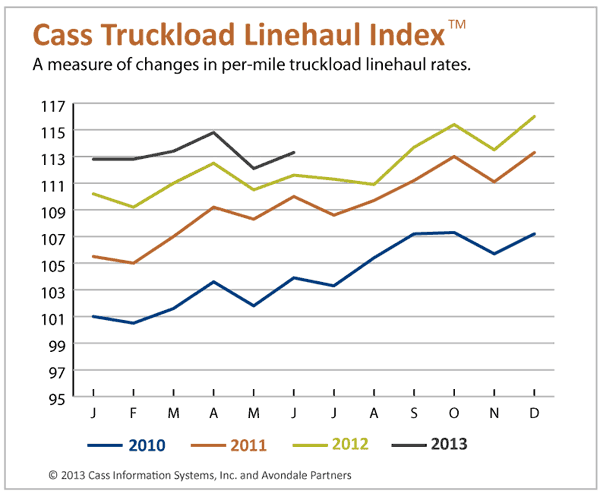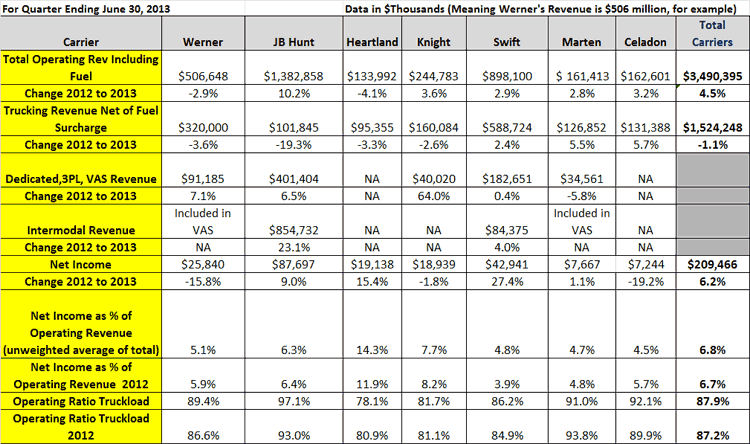From SCDigest's On-Target E-Magazine
- July 30, 2013 -
Logistics News: Mixed Q2 for US Truckload Carriers, as Evolution Continues for Many
Decent Profits in Slow Freight Environment, with Profits Up 6.2%, though Results Vary Significantly Across Carriers; Attraction to Intermodal, Dedicated and Brokerage Continues
SCDigest Editorial Staff
In an volume environment many characterized as "lackluster," public truckload carriers posted very mixed results in Q2.
SCDigest Says: |
 |
| In terms of pricing, the Cass Linehaul Index shows that rates, while falling versus Q1 as is typical, were consistently about 2% above 2012 levels. |
|
What Do You Say?
|
|
|
|
As always, SCDigest is here this week with a review of Q2 and the full first half of 2013 results from our group of seven publicly traded carriers (note:giant Schneider National continues to be a private company).
Last week, we covered the rail carriers. (See Union Pacific Separates Itself from the Pack in Q2.) Next week, we will be back with Q2 results for the LTL carriers.
From an overall industry perspective, the American Trucking Associations said trucking volumes (including LTL) were up 4.3% in April year-over-year, 6.5% in May and 5.9% in June, much stronger than most of the carriers in our group reported.
For example, Swift saw a rise of just 2.1% in loaded miles in Q2, which seemed about on par with most others. It could be, however, that part of the delta between ATA tonnage figures and carrier reports might be explained by growth in dedicated carriage, which is generally reported as a different segment than straight truckload business.
And the evolution of many carriers away from straight truckload to dedicated, intermodal and brokerage services continues apace at many in the industry.
Most notable, of course, at JB Hunt, where the truckload business continued its freefall in Q2, down more than 19% in revenue, and at a little over $100 million in sales accounts for just 7% of total revenues, down from 10% in 2012. The story is even more dramatic in terms of profits, where the truckload segment produced just 2% of total profits versus a still tiny 7% in Q2 last year.
But it isn't only happening at Hunt, even if this is the extreme case. Straight truckload revenues fell 3.6% in Q2 at Werner, while dedicated and intermodal segments rose a combined 7.1%. The truckload business at Knight fell 2.6 in Q2, but its brokerage business soared a robust 64%, though off a small base, and now accounts for about 20% of total revenue.
In terms of pricing, the Cass Linehaul Index shows that rates, while falling versus Q1 as is typical, were consistently about 2% above 2012 levels. That would seem at the high end of the range of our carrier group, which reported modest rate increases of 1-1.5% for the most part.

All told, it was a decent quarter for the TL carriers, with total revenues including fuel surcharge up 4.5%, while profits were up a decent 6.2% in aggregate, as shown in the table below.
Truckload Carrier Q2 2013 Results

See Full Size Image
But as can be seen, results varied quite a bit across carriers. Revenue fell 3-4% at Werner and Heartland while soaring 10% at JB Hunt, as usual on the back of its intermodal and brokerage segments. Revenue was up 3-4% at all the rest.
Profits were an even more unequal story, dropping sharply at Werner and Celadon, rising rapidly at Hunt, Heartland and Swift, and coming in nearly flat at Marten and Knight.
Unweighted (meaning size of revenues is not considered) operating ratios (operating expense divided by operating revenues) came in for the group at about 88%, a little above 2012 and decent but not outstanding performance.
(Transportation Management Article Continued Below)
|